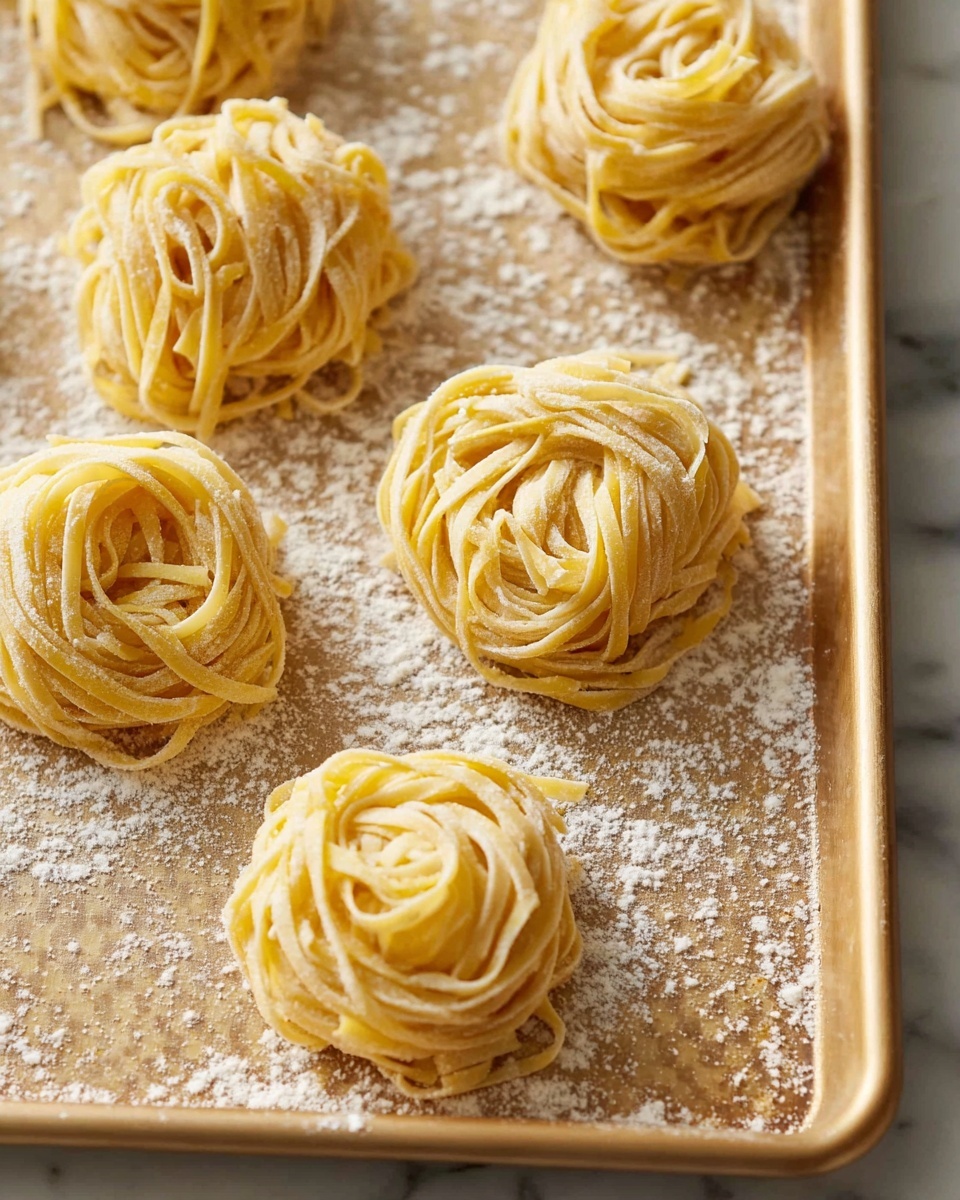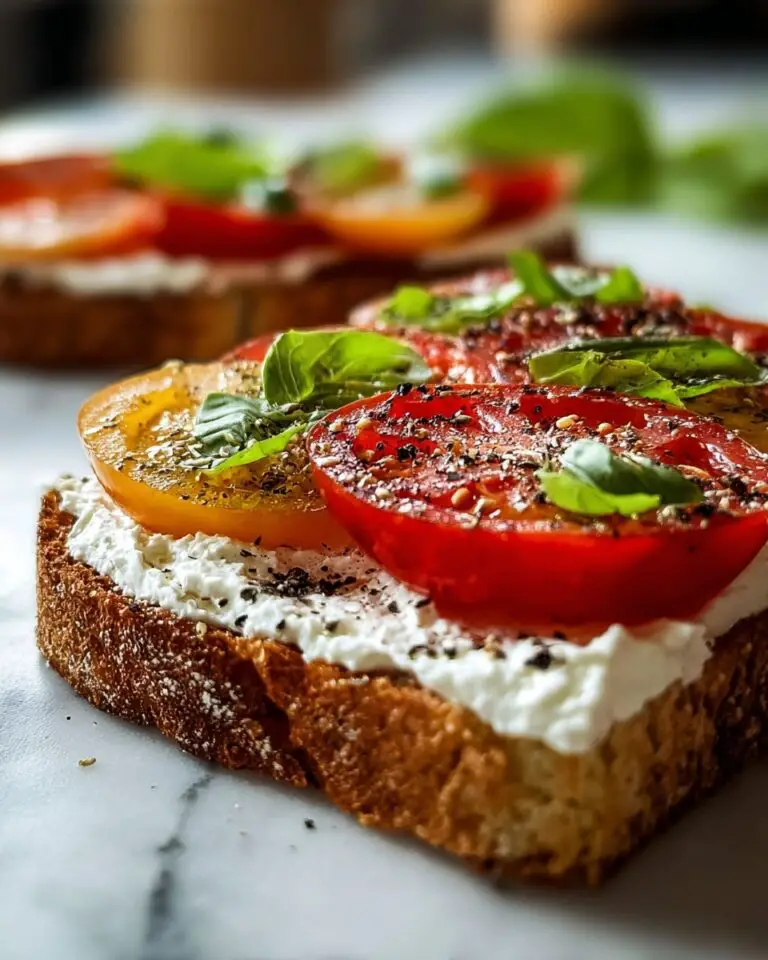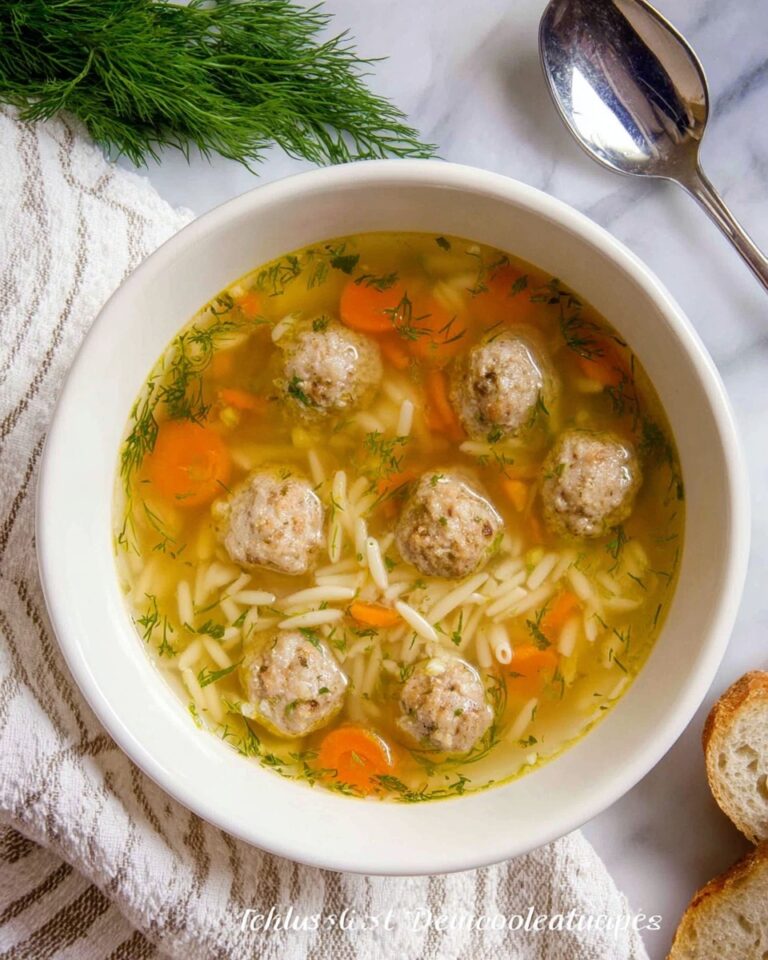If you’ve ever dreamed of making fresh, silky noodles from scratch that boast an irresistible texture and flavor, this Homemade Pasta Recipe is your golden ticket. It transforms just a handful of simple ingredients into delicate strands that will elevate any meal, making you feel like a true Italian kitchen maestro. Whether you’re a seasoned cook or a curious beginner, you’ll love how rewarding and fun it is to craft your own pasta at home.

Ingredients You’ll Need
The beauty of this Homemade Pasta Recipe lies in its simplicity and the quality of each component. Each ingredient has a distinct role, contributing to the dough’s perfect elasticity, taste, and lovely golden hue.
- 2 1/2 cups Italian-style “00” flour: This finely milled flour creates a silky smooth dough with excellent stretch and bite, but you can also use unbleached all-purpose flour if you prefer.
- 1 tsp fine sea salt: Adds just the right balance of flavor to bring out the natural richness of the eggs and flour.
- 4 large eggs: The foundation of the dough, providing moisture, binding, and a beautiful yellow color.
- 1 Tbsp extra virgin olive oil: Gives the dough a subtle silkiness and helps with pliability.
- Semolina flour: Used for dusting the baking sheet and noodles to keep them from sticking while drying or before cooking.
How to Make Homemade Pasta Recipe
Step 1: Prep Your Workspace
Start by dusting a large baking sheet with semolina flour; this will be where your fresh pasta rests after cutting to prevent sticking. Secure your pasta roller to a clean surface and set it to the widest setting—this makes rolling out the dough easier and ensures an even thickness for the first pass.
Step 2: Make the Dough
In a spacious mixing bowl, whisk together the flour and salt. Create a well in the center and crack the eggs right into it. Drizzle them with the olive oil before gently combining the wet ingredients with your fingers, slowly incorporating the flour from the edges. When the dough begins to form, turn it out onto a floured surface and knead it thoroughly until smooth and elastic—about five minutes is ideal. Then shape it into a disk, cover with plastic wrap, and let it rest at room temperature so the gluten relaxes; this makes rolling out so much easier.
Step 3: Divide and Begin Rolling
Using a bench scraper, cut the rested dough into four equal parts to keep it manageable. Keep the pieces you’re not working with covered to prevent drying. Flatten one piece into a rectangle that matches your pasta machine’s width, dust it lightly with flour, and roll it through the widest setting. Fold the dough like a letter, roll it through again, and repeat once more; this kneading through the machine adds elasticity and strengthens your dough.
Step 4: Roll to Desired Thickness
From now on, roll the dough without folding. Adjust your pasta maker to gradually thinner settings, rolling the dough multiple times until you reach your preferred thickness—setting two works beautifully for fettuccini. Always dust flour to prevent any sticking, and if the sheets grow too long to handle, slice them into shorter sections before continuing.
Step 5: Cut the Pasta
With the dough sheet flattened, dust it generously with flour so it won’t stick during cutting. Attach your pasta cutter and run the dough through to produce your noodles. Catch them carefully and spread them on your semolina-dusted baking sheet. Lightly dust the noodles again, cover with a kitchen towel, and let them rest dry for about 20 minutes before cooking or freezing.
Step 6: Cook Your Homemade Pasta
Bring a large pot of salted water to a rolling boil. Add your dried or frozen noodles gently, stirring at first to avoid clumping. Fresh pasta cooks lightning fast, usually in 2 to 4 minutes—watch closely so you don’t overcook. Frozen pasta needs just a couple extra minutes. Test for doneness by tasting: properly cooked pasta should be tender yet still have a firm bite, not an eggy rawness. Drain and prepare to serve!
How to Serve Homemade Pasta Recipe
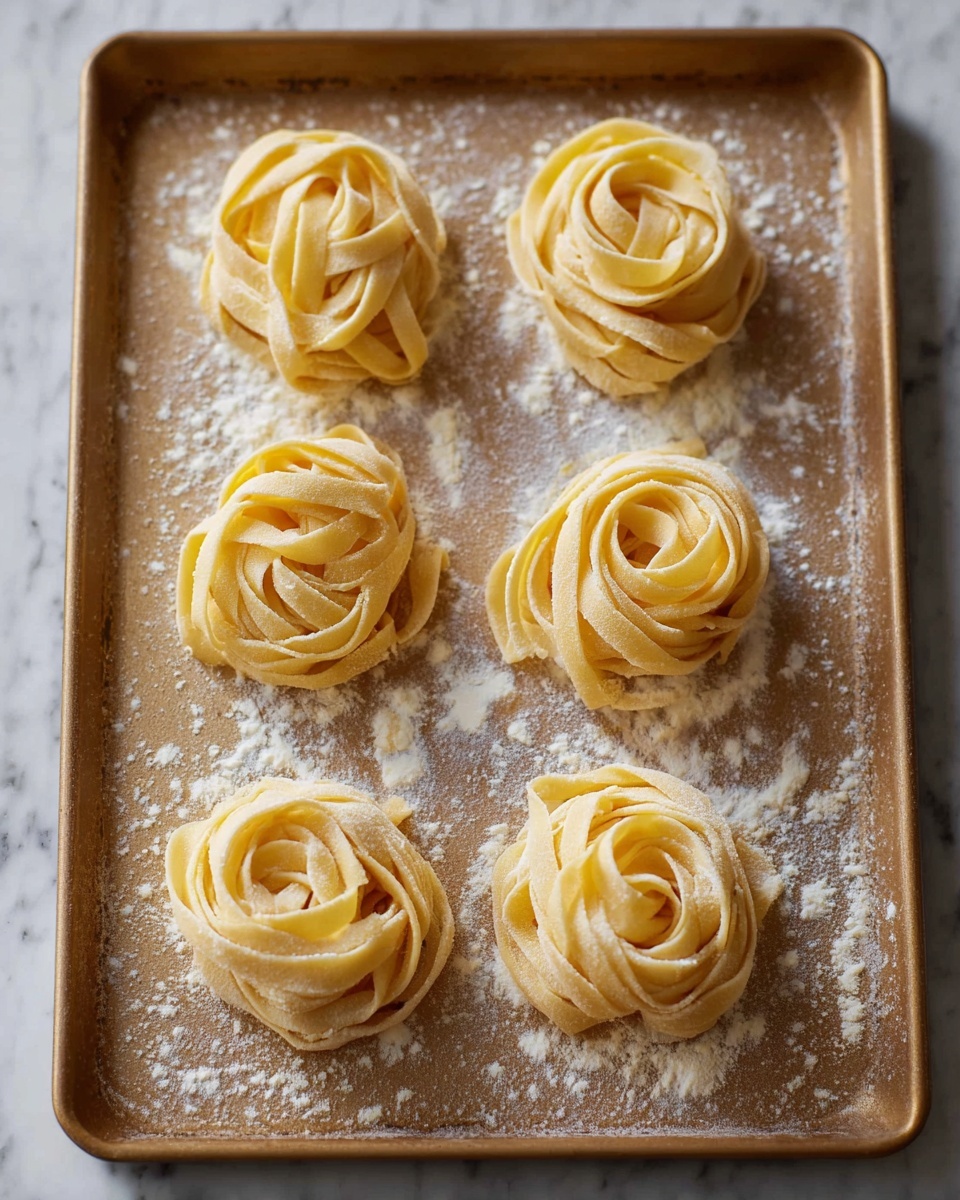
Garnishes
A homemade pasta masterpiece deserves thoughtfully chosen garnishes. Freshly grated Parmesan or Pecorino Romano adds that salty, nutty finish, while a sprinkle of fresh herbs like basil, parsley, or chives brightens each bite. Don’t overlook a drizzle of extra virgin olive oil or a twist of freshly cracked black pepper to amplify flavors.
Side Dishes
This delicate pasta pairs wonderfully with crisp, fresh sides to balance the meal beautifully. Think a simple arugula salad tossed in lemon vinaigrette, roasted seasonal vegetables, or even a classic caprese salad with juicy tomatoes and creamy mozzarella.
Creative Ways to Present
Serving fresh pasta can be as fun as making it. Twist your fettuccini into neat nests on the plate or pile it high for rustic charm. For dinner parties, present the pasta with a small ramekin of sauce on the side to let guests customize. You can also try lightly toasting your fresh pasta briefly in a pan with butter after cooking for an irresistibly golden crispness.
Make Ahead and Storage
Storing Leftovers
If you find yourself with extra homemade noodles, store them in an airtight container with a dusting of semolina flour to prevent clumping. Keep them in the refrigerator for up to two days to maintain freshness before cooking.
Freezing
To freeze your fresh pasta, spread the cut noodles on a semolina-dusted baking sheet and freeze until firm, about an hour. Then transfer them to a freezer-safe bag or container. This method keeps the noodles separate so they won’t freeze together in a clump and lets you enjoy fresh pasta anytime.
Reheating
Reheat frozen pasta by dropping it directly into boiling salted water without thawing first. Add about 2 minutes to the usual cooking time, and you’ll have perfectly tender, fresh-tasting pasta ready to enjoy instantly.
FAQs
Can I use regular all-purpose flour instead of “00” flour?
Absolutely! While “00” flour is traditionally preferred for its fine texture and elasticity, unbleached all-purpose flour works well in this Homemade Pasta Recipe if measured properly. You might notice a slightly different texture, but it will still be delicious.
Do I have to use a pasta roller machine?
While a pasta roller speeds up the process and creates consistent thickness, you can also use a rolling pin. It requires more effort to roll the dough evenly, but with patience, you can achieve great results by hand.
How long can I store fresh pasta before cooking?
If stored properly in the refrigerator, fresh homemade pasta lasts up to two days. If you want to keep it longer, freezing is your best bet to preserve freshness and texture.
Can I make this dough vegan or dairy-free?
This particular Homemade Pasta Recipe relies on eggs for structure and richness, so substituting eggs can be tricky. However, there are vegan pasta dough recipes available that use alternatives like water, oil, and flour to achieve a similar effect.
What sauces pair best with freshly made pasta?
Fresh pasta has a delicate flavor and tender texture, so lighter sauces like a simple tomato basil, olive oil with garlic and chili flakes, or fresh herb pesto complement it beautifully without overpowering the noodles.
Final Thoughts
There’s something truly magical about rolling out your own noodles and tasting the freshness that only homemade pasta can deliver. By following this Homemade Pasta Recipe, you’re not just cooking a meal; you’re creating an experience steeped in tradition and love. So grab your ingredients, get your hands floury, and let the joy of making pasta from scratch fill your kitchen and your heart. You’ll never want to go back to store-bought again.
Print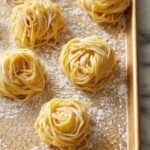
Homemade Pasta Recipe
- Prep Time: 20 minutes
- Cook Time: 4 minutes (approximate for fresh pasta)
- Total Time: 24 minutes
- Yield: 6 to 6.5 servings
- Category: Main Course
- Method: Stovetop
- Cuisine: Italian
Description
This Homemade Pasta Recipe offers a classic way to create fresh, tender pasta from scratch using simple ingredients like Italian-style ’00’ flour, eggs, olive oil, and salt. The dough is expertly kneaded and rolled through a pasta machine to achieve the perfect thin sheets, then cut into your choice of pasta shapes. Ideal for a hands-on cooking experience, this recipe produces pasta that cooks in just minutes and can be enjoyed fresh or frozen for later use.
Ingredients
For the Dough
- 2 1/2 cups Italian-style “00” flour (318 grams) or unbleached all-purpose flour (310 grams)
- 1 tsp fine sea salt
- 4 large eggs
- 1 Tbsp extra virgin olive oil
For Preparation
- Semolina flour (for dusting the baking sheet and cut noodles)
Instructions
- Prep: Dust a large baking sheet with semolina flour to prevent sticking. Secure your pasta roller and set it to its widest rolling setting to prepare for rolling out the dough.
- Make the dough: In a large mixing bowl, whisk together the flour and salt. Create a well in the center and crack the eggs into it. Drizzle with olive oil, then use your fingers to blend the eggs into the flour gradually. Stir the flour from the sides into the center until a dough mass forms. Transfer to a floured surface and knead for about 5 minutes until the dough is smooth, flexible, and not sticky. Shape into a ball, flatten into a disk, cover with plastic wrap, and let rest at room temperature for 20 minutes up to 1 hour.
- Divide and roll the dough: Cut the dough into 4 equal pieces with a bench scraper, keeping the unused dough covered with plastic wrap. Flatten one piece into a rectangle suitable for your pasta roller. Dust with flour to prevent sticking, then pass it through the pasta machine on its widest setting. Fold the dough into thirds like a letter and roll through the widest setting twice more to develop the gluten.
- Thin the dough: Without folding further, roll the dough repeatedly through the machine, decreasing the roller thickness setting each time until reaching desired thinness (setting 2 is ideal for fettuccini). Dust the dough with flour as needed to prevent sticking. If the sheets become too long to handle, cut them into smaller lengths.
- Cut the pasta: Dust the final dough sheet with flour, then change to your preferred pasta cutter attachment. Pass the sheet through the cutter, catching the noodles as they exit. Arrange cut pasta on the semolina-dusted baking sheet, then cover with a clean kitchen towel and allow to dry for 20 minutes before cooking or freezing.
- Cook the pasta: Bring a large pot of salted water to a boil. Add the dried or frozen pasta and stir gently initially to prevent sticking. Fresh homemade pasta cooks very quickly—check for doneness between 2 to 4 minutes (add 2 minutes extra when cooking from frozen). When cooked, drain and serve as desired.
Notes
- Use semolina flour for dusting as it helps prevent sticking better than regular flour without affecting flavor.
- Resting the dough allows the gluten to relax, making it easier to roll out.
- The thickness setting and shape can be adjusted to other pasta types like tagliatelle or pappardelle.
- Pasta sheets can be frozen after drying for up to a month; thaw briefly before boiling.
- Cook fresh pasta quickly to avoid an eggy taste and maintain a tender texture.

